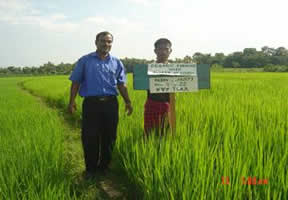Success Story
PADDY CULTIVATION USING BIOGAS SLURRY: A SUCCESS STORY
Background of the problem
Gandhipara is a village falls under the Betasing Block of West Garo Hills, Meghalaya where topography is located between 250N latitude and between 890 and 910 E longitude at an average MSL of 657 meter. The productivity of low land rice is very low as compared to other parts of the country due to non-application or hesitation to apply chemical fertilizers to increase the productivity of lowland rice. Hence, KVK (ICAR), West Garo Hills, Tura (Meghalaya) was made interventions for introduction and popularization of organic inputs in the locality through the use of biogas slurry in the rice field.
Farming situation
The paddy was grown under lowland irrigated farming system.
Existing problem
The productivity of low land rice is very low as compared to other parts of the country due to non-application or hesitation to apply chemical fertilizers to increase the productivity of lowland rice. Though the biogas slurry is available in the village but the farmers are not aware of use in paddy cultivation to enhance the productivity.
Methodology adopted
KVK, Tura has played a major role for application of biogas slurry in organic farming and to popularize the technology among the farmers of West Garo Hills. A training programme were organised regarding use an importance of biogas slurry in organic farming at village Gandhipara. A progressive farmer Shri Hardhan Mahanta expressed his desire to cultivate the paddy with the use of biogas slurry to increase the productivity without deteriorating the soil health. Accordingly, KVK, Tura was supplied about 20 kg of paddy seed (var.Aghoni bora) developed by AAU, Jorhat, Assam. A total of 3 units (1 unit = 1 acre) were tried for the purpose. 13 q (thirteen quintals) of biogas slurry was applied for each unit along with lime. The lime and biogas slurry were broadcasted in each unit of plot before final ploughing in the main field. 25 days old seedling was transplanted @ 2-3 seedlings/hill.
Production and productivity
Rice grown by using bio gas slurry was observed more greenery, producing more effective tillers than farmer’s practice. Insect-pest and disease incidence were also less and applications of botanicals were enough to control insect- pest and diseases, if appeared. Finally, the farmers got an average yield of 51.0 q/ha as compared to farmers practice with average productivity of 28.0 q/ha which increased 55 % in rice yield over farmer’s practice. It was also observed that the weed populations were very low with the application of lime along with bio gas slurry and sustained the fertility level of the field.
C: B Ratio
| Particulars | Cost of cultivation (Rs/ha) | Gross Return (Rs/ha) | C:B ratio |
| Bio gas slurry+lime | 12,250/- | 38,250/- | 1:3.1 |
| Farmer’s practice | 8,250/- | 21,000/- | 1:2.5 |
Marketing
Marketing is not a problem at all. The rice produced by using biogas slurry is having the same market price or sometimes higher price than the rice produce by farmer’s practice. The farmers generally sale in the local market like Graobadha, Ampati, Pipulbari, etc.
Spread in the area
A field day was organised to spread the technology to the neighbouring farmers and villages by showing the paddy field grown with the use of bio gas slurry where the farmers of neighbouring villages were expressed their view to use the bio gas slurry. The farmers of different villages of Betasing block of West Garo Hills district of Meghalaya are now growing rice by using bio gas slurry for sustainable production and soil health.
 |
|
 |
 |
Bumper Paddy crop at harvesting stage |
Farmers’ Field day on Paddy |
